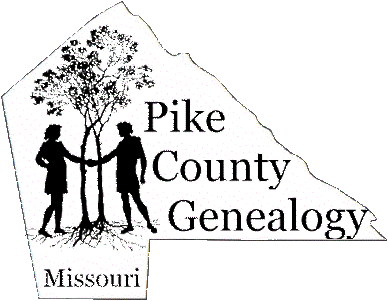

Pike County Poor Farm
The Pike Co. Mo. poor farm was established by the County Court in February 1860. It purchased a tract of land from John B. Henderson, located in Ashley township, just northwest of the town of Ashley. The land was located 52N, Range 3 W, Section 22.
It was placed under the direction of a superintendent, who was a salaried office of the county. The farm was stocked with necessary farm implements and livestock. Labor to run the farm was to be furnished by the inmates who were able to work. Produce from the farm was used to feed the inmates and any excess produce was sold and the proceeds used to buy clothing, etc.
The superintendent was furnished room and board for his family at no cost. Generally the overseeing of the house was left to the wife of the superintendent. She was unpaid until 1903 when the Court started paying the wife or matron of the farm $125.00 per year for her services.
The superintendents who managed the poor farm are: Alphues Strother in 1870; Mr. T.E. McNalley in 1880; Edward G. Michie was overseer in 1900 and in 1910; Willard Turpin was the overseer in 1920; and Frank Nestor became overseer in November 1929. Vernie Shaw was the last overseer.
An 1870 census of the Pike County Missouri poor farm in the Ashley township can be viewed here.
A reporter from the Bowling Green Times visited the Farm in 1946 and from that report it would appear that there had been little change in the running or life at the Farm. Following is an abstract of that article.
![]()
Bowling Green Times, Bowling Green, Mo
Thursday, April 25, 1946
"No snow falls lighter than the snow of age;
but none is heavier, for it never melts"
County Farm Facilities--A Monument to Public Indifference
Upon assignment your Times reporter recently visited the County Farm located about 6 miles sw of Bowling Green on a side road leading off of the Ashley road to ascertain and report conditions and facilities as he found them.
Frank Nester, Supt. of the County Farm, became Supt. in Nov. 1929 and has for over sixteen years been in personal charge of the property and residents. T.M. McNelly was in charge prior to 1879 and succeeded later by Willard Turpin and Edward G. Michie.
I hold no brief for Supt. Nester, nor any one else, but am obligated to state that I found his administration as near perfect as the ancient and outmoded facilities will permit. Both he and Mrs. Nester are most considerate of the charge they have assumed and in an intelligent and painstaking manner minister as Christian people should to the physical and mental requirements of the people who reside there. On duty 24 hours a day----when residents are ill, medical assistance is readily available from a Bowling Green doctor.
The property consists of 170 acres of good farm land. Originally it was intended that the farm would be cultivated by the residents there but with the inauguration of the old-age pension system, the County Farm is left with only those persons who are physically and mentally, unable to work. Despite such fact, Mr. Nester has, by hard work and application to duty, 27 head of cattle, 45 to 50 head of hogs, including pigs, two horses and 200 chickens. Last year sold from the farm approximately $3000.00 worth of products, which funds go into the County Treasury. Tractor and equipment have been furnished for his use. The farm, livestock and equipment deserve no criticism.
The housing facilities are a monumental disgrace. The buildings, antiquated frame construction, were built prior to 1860, except a barracks building erected with W.P.A. funds in 1934.
The buildings are without sanitary or modern appliances of any kind whatsoever. Electricity is not available and the century old oil lamps are used for illumination, dangerous and of no practical value. Mr. Nester advised me he had extinguished at least ten to twelve fires that had started there from various causes in the past 16 years. There are no water supply or facilities for putting out a fire.
The buildings are heated by stoves. There are 12 stoves in the eight rooms, not including Mr. and Mrs. Nester’s living quarters which are also old and antiquated.
There are at present 15 residents there, seven white men, five white women, two colored men and one colored woman. The oldest is about 85 years of age. Many are borderline cases as to mentality. The greater portion are senile and almost incapable of caring for themselves. Two men, in the two years they have been there, have never been to the dining room but have had meals brought to them.
Bath facilities are wash tubs but Mr. Nester see that residents are clean.
About 1/2 of the residents can’t read because of poor eyesight and poor lighting even in day time. Glasses are furnished by the County. There are a few cases of illiteracy. Books and magazines are furnished by Mr. Nester thru courtesy of our bookstores.
When weather is good some get out and walk around the yard. The greater portion go back to their beds. Residents retire about 7 pm.
No religious services are available. When a resident dies a pine box is provided. Mr.. Nester says a prayer and the mortal remains are consigned to the Earth. A cemetery is maintained nearby for those who die and when bodies are unclaimed. (Cemetery has been destroyed.)
![]()
|
|